Investments in the city’s tourism, hospitality and convention industries stand to alter the landscape of Downtown Long Beach over the course of the next decade. New hotels, a new development around a repaired and refurbished Queen Mary, an expanded Aquarium and upgrades to the convention center are all in the works, plus there is the possibility of international flights at the Long Beach Airport. These investments, according to local industry professionals, represent unprecedented potential for the city as a meeting and tourism destination. If all unfolds as planned, the future, they believe, is bright.
When asked in an interview with the Long Beach Business Journal what the potential of these developments means for the future of the city’s hospitality and tourism industry, Steve Goodling, president and CEO of the Long Beach Convention & Visitors Bureau (CVB), said he normally phrases that question in the form of a statement.
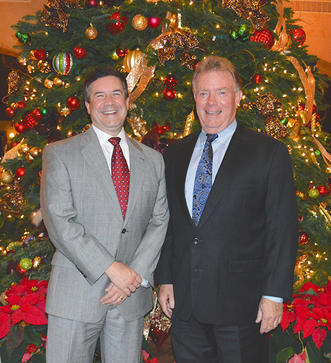
Steve Goodling, left, president and CEO of the Long Beach Convention & Visitors Bureau (CVB), is pictured with CVB Board Chair William H. Collier, Jr., at Virginia Country Club during Long Beach Camerata Singers Annual Holiday Gala on December 1. The event honored Goodling as the second recipient of the Beverly O’Neill Arts Leadership Award. This year he has led the renovation of the Center Theater, its renaming as the Beverly O’Neill Theater, and its new life hosting five Long Beach arts organizations, including Camerata. O’Neill served as mayor of Long Beach from 1994 to 2006. (Photograph by the Business Journal’s Larry Duncan)
“I have said for years that, if Long Beach were a stock, you would invest in it, because its trajectory is continually going up,” Goodling said. Following the interview, Goodling said he was set to meet with a group interested in buying an existing hotel in Long Beach – an indication that outside investors are taking notice of the city’s momentum.
This year, the Long Beach City Council approved a deal to construct a new, 427-room hotel at the southeast corner of Ocean Boulevard and Pine Avenue. Another is currently underway at Douglas Park. Bruce Baltin, managing director of CBRE Hotels and a Long Beach resident, said he personally knows of two or three additional new hotels being discussed for Long Beach, although discussions are preliminary. Baltin said he expects the new hotels to help the local hospitality industry rather than dilute the market.
“One of the challenges that the CVB is having right now is getting hotels to commit enough rooms to conventions, because they are doing so well in other areas,” Baltin said. Having additional hotels would allow the CVB to attract larger conventions, he noted.
In addition to investments in the city’s attractions and hotels, Goodling pointed to various residential developments in downtown as a sign that the area is on its way up. “This downtown continues to emerge more as a great playground where visitors and locals are out on the street,” he said. “We hear that from our clients.”
Development Of The Queen Mary Site And Expansion Of Carnival Cruise Line
Urban Commons, a Los Angeles-based real estate development and investment firm, recently took hold of the lease for the Queen Mary and surrounding acreage. Guided by recommendations from a special task force assembled by the city, the company is working on a master plan that not only includes revitalizing the historic ship but also developing the surrounding land.
First on the company’s list of to-dos is making necessary repairs to the ship – which are beginning right away – and improving amenities on board. “Those renovations include a $15 million plan to greatly enhance the guest rooms, restaurants and public spaces, as well as necessary structural renovations,” Taylor Woods, principal of Urban Commons, told the Business Journal via e-mail.
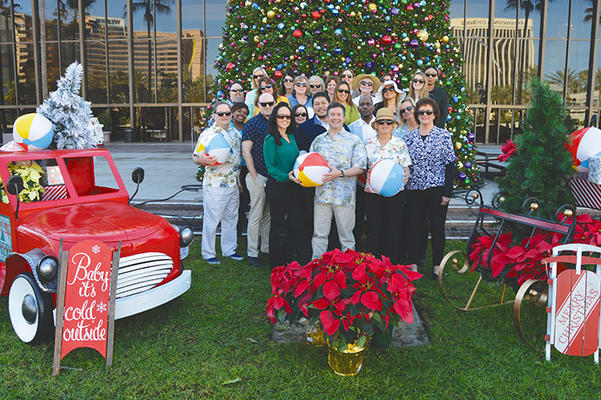
The staff of the Long Beach Convention & Visitors Bureau make it their business to bring business to Long Beach. Clients know them for their personable, high-touch approach to relationship building. Pictured in the front row, from left, are: Jennifer Kohatsu, Steve Goodling, Cindy Robbins and Jan Miller. In the second row, from left, are: Bob Maguglin, Loren Simpson, James Robinson, Jenni Pearl, Aristotle Marinas, Michael Mitchell, Barbi Ajemian. In the third row, from left, are: Jeff Forney, Blanche Campain, Kathy Ford, Lillian Olguin, Iris Himert, Claudette Baldemor, Erica Morris. And pictured in the back row, from left, are: Caribe Hourigan, Susan Valen, Pauline Taylor, Carolyn Derrico, Allison Lesser, Jamie Dominguez and Terrie Jackson. (Photograph by the Business Journal’s Larry Duncan)
In an August interview with the Business Journal, Woods had indicated that developments around the ship might include a marina, shops, restaurants, green spaces, a bike path and an amphitheater.
“Urban Commons is currently working with the City of Long Beach to develop the master plan based on the set of guiding principles set forth by the Queen Mary Land Development Task Force,” Woods wrote in his e-mail. “Details on specific elements of the master plan will be released to the public as they are confirmed.”
Woods continued, “Through a $15 million interior renovation plan and a first-of-its-kind entertainment destination developed on the surrounding land, we hope to enhance the draw of this special location and create an exciting entertainment destination in the heart of Long Beach.”
Michael Bohn, senior principal of local design firm Studio One Eleven, led the Queen Mary Land Development Task Force created by Mayor Robert Garcia. He said he hopes Urban Commons’ final plans will factor in community use as well as day visitors and overnight tourists.
Woods indicated his company intends to do just that. “The Queen Mary is the 15th most popular tourist attraction in the United States, and our visitors have long included locals as well as out-of-towners,” he wrote. “The dynamic entertainment destination that we envision creating will be unlike anything else offered in Southern California, and most likely the world, and will appeal to a broad local, national and international audience.
“We also recently signed an agreement with Carnival Cruise Line to expand their terminal operations at the Port of Long Beach, thereby tripling the size of their footprint.” Woods called Carnival “a tremendous asset for the Long Beach community and a huge traffic driver to the Queen Mary. Carnival’s success will only add to the vitality and energy of what promises to be one of the top destinations in California.”
Carlos Torres de Navarra, vice president of commercial port operations for Carnival, said his company is taking full use of the dome adjacent to the Queen Mary in March. The cruise line has been using a portion of the dome as its terminal and, through an agreement with Urban Commons and the city, is going to build out the rest of the dome to accommodate more passenger traffic. Eventually, Urban Commons will build Carnival a replacement terminal so the dome may be used for other purposes.
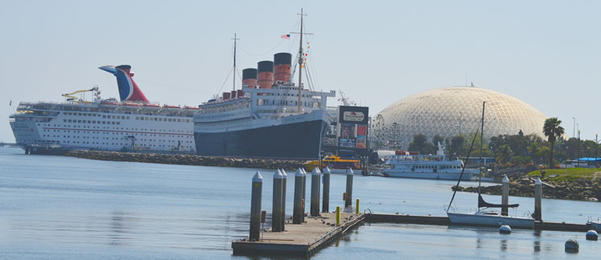
Urban Commons, the master leaseholder for the Queen Mary and adjacent property, is working with the city on a master plan for development of the property. Plans may include a marina, shops, restaurants and an amphitheater. Carnival Cruise Line will be taking over the entire dome adjacent to its terminal next year, and by 2018 expects to accommodate another 100,000 passengers a year through its Long Beach facilities. (Photograph by the Business Journal’s Larry Duncan)
The company plans to replace one of its three ships operating from Long Beach with the Carnival Splendor, a larger vessel, by 2018. “We’re going to have about 650,000 guests [per year] sailing out of Long Beach when the Splendor comes in,” Torres de Navarra noted. That’s about 100,000 more visitors than the cruise line already draws to Long Beach.
Also as part of the agreement, Carnival is gaining infrastructure to allow its ships to plug into shore power, which is cleaner for the environment than running its engines at dock. “We’re in the process of finalizing our drawings and going to an RFP process to develop the expansion of the dome as well as the additional shore power,” Torres de Navarra said. “We will be completing those projects by the end of 2017.”
But the expanded terminal and larger vessel aren’t the only ways Carnival is looking to enhance its Long Beach operations.
“There are various thresholds we need to overcome to grow the business. And it’s not only in the next year or two years. I am talking about five, 10 or 15 years down the road,” Torres de Navarra said. “If you look at the ports that we go to right now, it’s not a lot. So certainly the diversification of the port itinerary is something that will drive the growth for the long term.”
Currently, Carnival offers cruises to Hawaii; Baja California, Mexico; and the Mexican Riviera from Long Beach, with Alaska voyages planned for the future. But the ports Carnival ships dock at in Mexico – Ensenada, Cabo San Lucas, Puerto Vallarta and Mazatlan, for example – haven’t seen improvements in decades, according to Torres de Navarra. “Those ports have been around since the days of ‘The Love Boat,’” he said, referencing the 1977-86 TV series about a cruise ship and its crew and passengers.
“Our focus right now is not only to improve the experience at those destinations through investment, but we’re also looking at potentially creating new ports along the Baja peninsula in Mexico,” Torres de Navarra said.
“What we need to do now is work on diversifying the product,” Torres de Navarra said. “Not only does that include new ports, but it’s also creating new experiences at those destinations by being a lender or some type of partner in new ideas that can in some cases redefine what the port experience is in, say, the Port of Ensenada.”
Creating new ports in Mexico is a complicated strategy for investment due to having to factor in the interests of local, state and federal governments, but Torres de Navarra sees it as key in growing demand for cruising from Long Beach and Southern California as a whole. “That’s really our objective, to drive those new experiences and thus drive additional demand and more yield on the ticket price,” he explained.
Working the City of Long Beach and local businesses is also key to Carnival’s growth, according to Torres de Navarra. “The story is going to be played out as follows: it’s all about developing a stronger partnership with the city and the businesses in Long Beach,” he said. “We need to find a way to grow the demand for cruising out of Long Beach. And the only way to do that is to again work with the city and the various businesses there to sort of create an environment where people want to cruise out of Long Beach.”
The Aquarium Of The Pacific Expansion
The Aquarium of the Pacific, the city’s largest attraction in addition to the Queen Mary, plans to break ground on a new wing called Pacific Visions on February 2, 2017. The wing will extend out onto the lawn at the north side of the property, which is located south of The Pike Outlets on the waterfront at Rainbow Harbor.
Pacific Visions will feature unique architecture for the area, completely covered in glass paneling. Inside, the new wing will house the 300-seat Honda Pacific Visions Theater, which will include a digital projection wall that is 32 feet tall and 130 feet long with a 180-degree arc and a floor projection disc measuring 30 feet in diameter. Prior to entering the theater, visitors will walk through an art gallery related to the educational film presentation in the theater. Upon exiting, they will walk through an exhibit gallery featuring live marine animals relevant to the screening.
“That will change the landscape of Long Beach as a tourist destination, both because it will be an architectural icon and it will be the most distinctive aquarium and informal ocean science center in the world,” Aquarium President and CEO Jerry Schubel said. No other aquarium in the United States has created such a feature, he noted. “I think it will redefine what people think of as aquariums and what their roles are.”
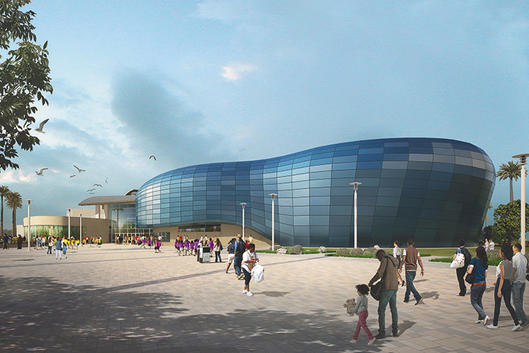
Pacific Visions, a planned expansion of the Aquarium of the Pacific, is slated to break ground on February 2, 2017. The expansion features a new 300-seat theater, an art gallery and a live animal exhibit, and will be dedicated to education about the changing environment and the role of humans, and impacts to marine life. (Rendering provided by the Aquarium)
The theater will be used to inform visitors about human-caused changes in the environment and impacts to marine life. “Our feeling is that we have to provide a platform for people to be able to explore alternative pathways to the future and discover how our actions are determining what that future will be,” Schubel said. “We hope at the same time after they have done this that they will look at our live animals in a very different way and understand that our fate as humans is very intimately intertwined with the fates of other living animals on this planet, both terrestrial and marine.”
The expansion is increasing the Aquarium’s capacity. “We’re going to be increasing the number of visitors on a yearly basis by about 200,000 people,” Schubel said. Most of these visitors will be from outside Long Beach, he noted. “It will have a big impact on the tourism in Long Beach.” The expansion will be completed by the first quarter of 2018, Schubel said. He expects two million visitors in the first year.
Reflecting on the Aquarium’s expansion as well as the Queen Mary site development and Carnival Cruise Line growth, Schubel said Long Beach has the potential to become “significantly more attractive as a tourist destination.”
In the future, he hopes to see more attractions in Long Beach. “We need more attractions so people will come and stay overnight and go to the Aquarium and Queen Mary and MOLAA [Museum of Latin American Art] and the Long Beach Museum of Art and the ranchos,” he said. “So I think we have to add more attractions and do a better job of packaging those attractions.”
International Flights At The Long Beach Airport
While the jury – which in this case is the Long Beach City Council – is still out on whether or not a federal inspection services facility for U.S. Customs at the Long Beach Airport will be built in coming years, one thing is certain – the city’s main airline, JetBlue, wants international flights.
Morgan Johnston, manager of corporate communications for JetBlue, wrote in an e-mail to the Business Journal: “We’ve long expressed our interest in serving a number of destinations south of the United States, including Mexico and Latin America. On the heels of our opening our 100th city and fourth in Cuba – Havana – JetBlue continues to demonstrate the value of international destinations, and after nearly two years and a very extensive study which showed favorable impacts on the city, we are eager for the council to finally move forward with the long-delayed request for a Federal Inspection Services (FIS) facility.”
Asked if international flights would benefit Urban Commons’ efforts at the Queen Mary site, Woods responded, “Bringing international flights to the Long Beach Airport would certainly add to the accessibility of the Queen Mary and aid in our efforts to draw more international visitors as Urban Commons prepares to introduce a world-class entertainment destination on the land surrounding the ship and implement $15 million in renovations onboard the ship to restore the Queen to her glory days.
“Long Beach is undoubtedly a growing commercial, cultural and tourism hub and a sought-after Southern California destination for many travelers and we believe that adding international flight offerings would have a tremendous positive impact on the entire City of Long Beach.”
“I see no downside. This is a win-win for Long Beach,” added Business Journal Publisher George Economides, a staunch advocate for international flights. “These flights will add an exclamation point to Long Beach being a destination city, an international city, a port city, a beach city, a burgeoning arts community and one of the most diverse cities in the country. I cannot imagine the city council not moving forward immediately.”
The council is slated to hold a study session on an independent report about adding an FIS facility at its December 13 meeting.
The Long Beach Convention & Entertainment Center
The Long Beach Convention & Visitors Bureau (the nonprofit organization that brings convention and meeting business to the city), the Long Beach Convention & Entertainment Center and the City of Long Beach continue to work together to improve the center and position it as a contemporary venue with built-in cost savings.
The biggest investment in the center – which comprises an arena, two theaters, ballrooms, meeting rooms and more – following the creation of the Pacific Room at the Long Beach Arena, is taking shape in the form of a pedestrian bridge that will connect the Terrace Theater Plaza to the convention center’s promenade on South Pine Avenue. The bridge will not only make it easier for convention attendees and visitors to navigate the convention center, it will also create greater connectivity from Ocean Boulevard to the downtown waterfront.
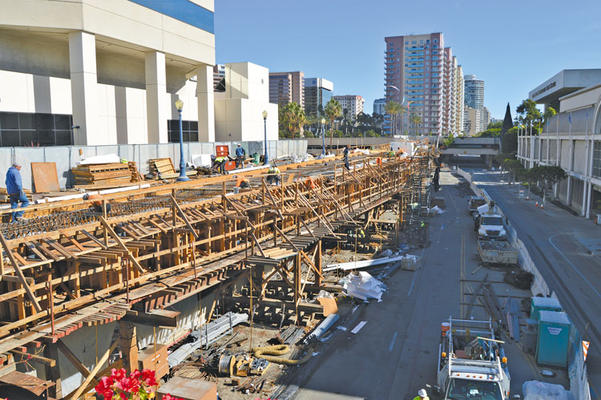
Construction of a pedestrian bridge to provide better connectivity from the convention center’s promenade to the Terrace Theater is underway. The bridge is designed to mimic the movement of waves. Its underside at the entrance to the center’s Seaside Ballroom will feature lighting and installations to create an outdoor event space with an under-the-sea theme called The Cove. (Photograph by the Business Journal’s Larry Duncan)
In addition to serving as a walkway, the bridge has also been designed as an art piece in the shape of a wave. Its underside outside the entrance of the Seaside Ballroom at the convention center will create an outdoor event venue called The Cove through installed lighting and decorative features mimicking an undersea environment.
Additionally, outdoor stage lighting and speakers are currently being installed on the Terrace Theater Plaza, making it a ready-to-go event venue. Renting such stage lighting would typically cost an event planner $80,000 according to Goodling, but at the convention center, the equipment comes free. “It’s designed to facilitate really cool parties which every association and corporation wants,” he said.
The bridge, The Cove and improvements to the plaza should all be complete in March, Goodling said.
“Probably the next biggest thing is the fountain,” Charlie Beirne, general manager of the convention center, who joined Goodling in the interview with the Business Journal at the CVB’s office. “We hope we’re going to make that fountain a focal point of the facility as well. We’ll redo the whole thing. . . . We have done some research on it and have had some schematic videos done [showing] what it may look like.”
The convention center is also in need of some “less sexy” improvements, as Goodling put it. For example, air conditioning units in the arena have to be replaced, as does furniture in the Seaside Ballroom pre-function area. “We’re a busy building,” Beirne said. “We had about 1.4 million visitors last year to the facility. That’s a lot of wear and tear.”
“For the city, it’s important that the asset has been upgraded and enhanced and repositioned,” Goodling said, referring to the $40 million in upgrades and renovations to the center in recent years. “Repositioned is a key word because it was designed strategically to foster and facilitate networking and to create ‘wow’ experiences. Those are two objectives of conventions when they choose a city. Our building now meets and is in line with helping to achieve those objectives.
“Going forward, we need to keep that momentum. At the same token, we need to take care of the mechanical needs of the building. So that’s important. And the challenge when the resources are tight is, how do we keep that up?”
As a city asset on the waterfront, the convention center gets funding for improvements from the city’s Tidelands Fund. Revenues flowing into that fund are dependent on the city’s oil sales.
“Tidelands has been a wonderful benefactor. The city management team, the mayor and the council, and even back to Mayor [Bob] Foster and the council at that time have all been very supportive,” Goodling said. “But with oil being down right now, it has been very challenging. Our hope is that oil will rebound here at some point in the near future so that we can continue taking care of the infrastructure of this facility,” he said.
The convention center generates about $300 million in estimated economic impact each year, Goodling noted. “We know we are going in the right direction. It’s just a matter of the oil economy supporting our needs,” he said.
